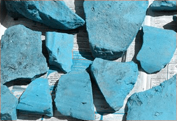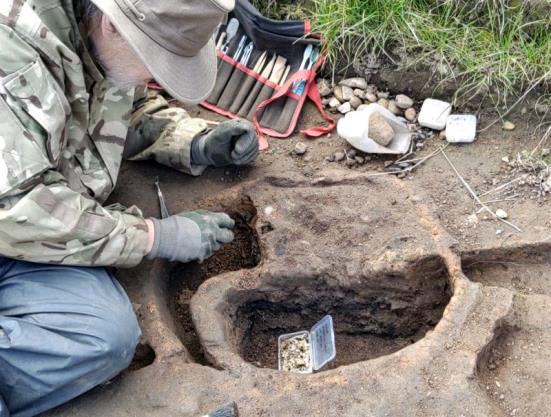

| No.272 September 2024 | Monthly Newsletter |
Smithills Moor and Winter Hill Tour |
 This, our second trip of the year, was a follow up to last year's visit to the ancient monuments on Anglezarke and Rivington Moors. It turned out to be just as interesting. Despite the unpredictable weather, we had a good turnout with just over 20 congregating on Horrocks Fold car park. We were led once again by Derek Cartwright and Garry Rhodes, both from the Heritage Centre in Horwich. Setting off across the moors, it wasn't long before we came across the main subject of our visit i.e. the enigmatic Wimberry Hill Tunnel. Although the entrance was barely visibly in the undergrowth, we could still see that it was over a metre wide but less than a metre high. This suggests it wasn't meant for human use. Dry-stone side walls could be seen holding up the large stone slabs of the roof. This suggests it was constructed by cutting a trench then backfilling forming a ridge about a metre above it. A recent survey revealed the tunnel to be 56m long and is now blocked at its northern end. It has no internal chambers and is roughly level but is not straight having two 45o bends, first to the right then to the left. It also does not appear to be connected to any other structure and Derek said it always appears to be dry. The tunnel does not appear on any map and despite a good deal of research has defied all explanation. After a good deal of pondering the tour continued, our next feature being the reservoir built in the 19th century for the Dean Mills at Barrow Bridge. Here the weather was taking its toll and the team decided to split, one group returning to the car park whilst the other continuing on the tour. Our group of intrepid ramblers eventually reached the Winter Hill Cairn on the north side of the TV and tele-communications masts. On the way we encountered a number of interesting sites. If you want to know more about this adventure, here is the full story. Aspull Ring Ditch ProgressLast month I reported on the sections cut at right-angles across the central sandy clay mound. We've now cut another section on the southeast side of our second urn which is starting to show that the mound was constructed in at least two different ways. In this area the mound seems to be mainly built of loose stone like a cairn, whereas the rest is fairly clean sandy clay. In other places however, the sandy clay is edged by loose stones. Our section at right-angles to this, going through our second urn, is also producing exciting results, particularly on the northwest side. Here a collection of large flat stones seem to be arranged in the form of a small cist lying under the sandy clay mound. Nothing can be seen as yet inside but fragments of bone are turning up in the immediate vicinity (we've installed covers for the moment to protect the internals).  Further work on the octagonal has feature revealed side walls and a base perhaps which seems to indicate that it is indeed a vessel. The style though is highly unusual. More and more cremated bone is coming out between intermittent layers of charcoal which suggests multiple burials (perhaps a family plot).  We now have the result back from CARD who have analysed a fragment of cremated bone form our first urn. This has give a date ranging from 1891 to 1688 BC i.e. mid Bronze Age which is very similar to the date we got for the charcoal from the burnt layer. As always, you can follow our progress on our blog site here. Next MeetingWednesday 4th September - at the Real Crafty on Upper Dicconson Street starting at 7.30pm as usual. This month we will be having Al and Al, Creative Directors of the Haigh Hall redevelopment programme. This is a rearranged meeting from last April which had to be cancelled due to issues with our venue. Al and Al are enthusiastic designers who will be explaining what has been achieved so far and what the plans are for the future. As mentioned before, it's an iconic site which has been much loved over the years by many generations of Wiganers, so it great to see that it's eventually getting the attention it deserves. Hope to see you there - BA. |